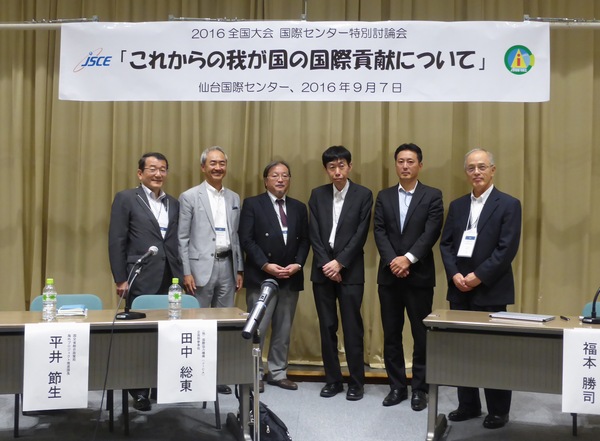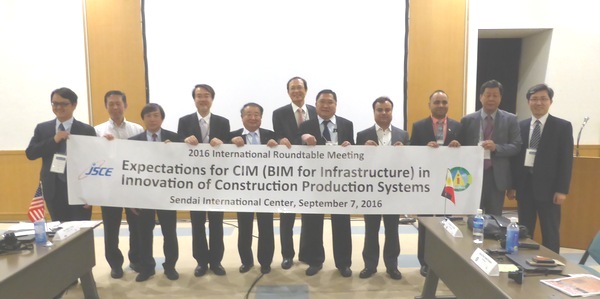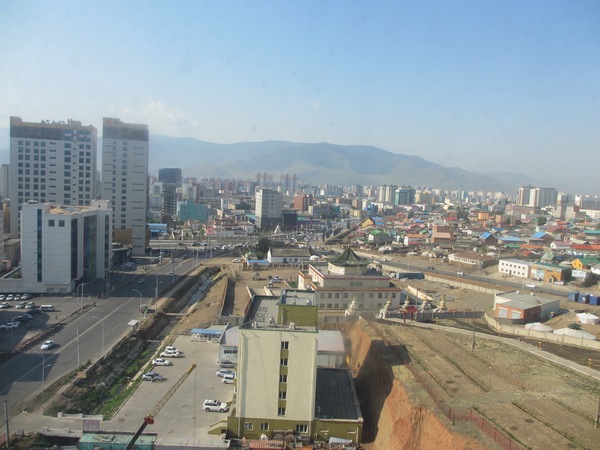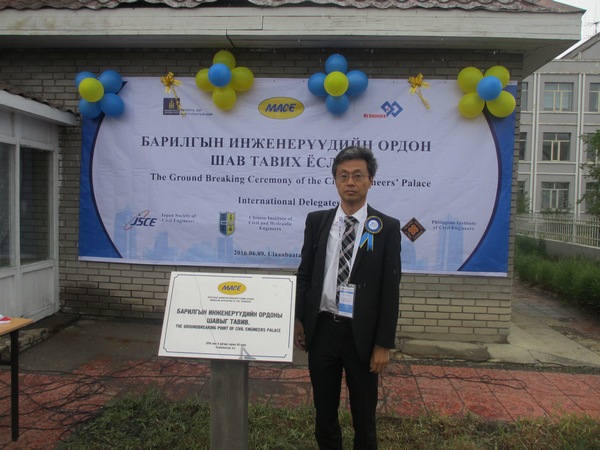IAC News
IAC News No.48, October 2016
Japan Society of Civil Engineers International Activities Center October 3, 2016 IAC News No.48
2016 Annual Meeting, International Program
-Report on Special Discussion-
“Future Contribution to the Development of Infrastructure in Developing Countries”
As part of the International Program of the 2016 Annual Meeting on September 7, 2016 at the Sendai International Center, a special discussion entitled "Future Contribution to the Development of Infrastructure in Developing Countries" was jointly held by the Japan Society of Civil Engineers International Activities Center (JSCE IAC) and the Japan Society of Civil Engineers Construction Management Committee (JSCE Construction Management Committee).
Mr. Katsuji Fukumoto from Obayashi Corporation, Vice Chair of the Sub-Committee on Official Development Assistance (ODA) of the JSCE Construction Management Committee, delivered the opening remarks. Afterwards, Mr. Fusato Tanaka, the Japan International Cooperation Agency (JICA), Mr. Setsuo Hirai, the Ministry of Land, Infrastructure, Transport and Tourism (MLIT), and Mr. Fukumoto, JSCE each gave a presentation on future challenges to be addressed.
Mr. Tanaka from JICA discussed the efforts being made with regard to Official Development Assistance (ODA). Particular emphasis was placed on JICA’s efforts toward the realization of "High Quality Infrastructure" in developing countries in line with the government's policy of "Partnership for High Quality Infrastructure," which has been followed since 2015. For example, JICA utilizes yen loans as one of the tools for achieving this goal: During the four years before FY2015, the scale of yen loans for each fiscal year had been limited to about 1 trillion yen; however, in FY2015, the scale reached about 2 trillion yen, nearly twice the amount. In addition, ODA yen loans, which have previously been utilized mainly for general road construction are now being used for more advanced construction projects, for example, railway systems and road structures such as bridges. This shift in the application of yen loans is helping to achieve the government's goal of assisting in the development of "High Quality Infrastructure." At the same time, developing countries now need more support in the area of software infrastructure, such as the development of maintenance management systems and traffic safety measures, rather than the conventional construction support. Mr. Tanaka introduced several of the support and assistance programs, including the training and dispatch of engineers, that JICA is implementing in cooperation with the MLIT.
Mr. Hirai from the MLIT explained the approach that they are taking for the export of high quality infrastructure. He referred to the MLIT’s three primary areas of focus: participation in the development of infrastructure from upstream (conceptual stage) activities, assistance from the private sector, and development of software infrastructure. For example, to promote assistance from the private sector, the Japan Overseas Infrastructure Investment Corporation for Transport & Urban Development (JOIN) was established in 2014. This makes it possible for the government and private companies to jointly invest in overseas projects through JOIN, which can reduce the risk carried by private companies. Additionally, by assisting in the advancement of projects, JOIN creates a favorable investment environment for private companies. As a result, JOIN has made investments in four projects including the Texas High Speed Railroad Project in the USA and the Complex Urban Development Project in Myanmar.
The presentation given by Mr. Fukumoto of JSCE outlined the activities conducted by the ODA Sub-Committee. The ODA Sub-Committee was established to address problems found in ODA projects, such as cases in which a project cannot be completed with the required quality, on time and within the budget. As a means for solving these problems, the application of the new Wrap-up Construction Service (WCS) is currently proposed. WCS is a project delivery scheme that allows providers with construction knowledge to participate in a project and collaborate with the project owner from the initial stage through to completion of the project. JSCE explained how WCS works.
The above three presentations were followed by a panel discussion, with Prof. Seiya Kinoshita from Nihon University, Mr. Junji Shibata from Oriental Consultants Global Co., Ltd., and Mr. Satoru Tsutae from Taisei Corporation invited as panelists.
Prior to the discussion, from the standpoint of a consultancy company involved in the upstream side of the business activities, Mr. Shibata introduced the roles and tasks of a consultant who is responsible for supporting overseas business activities. Next, from the standpoint of a construction company involved in the downstream side of the business activities, Mr. Tsutae introduced the infrastructure constructed in past overseas support projects and explained the risks associated with overseas construction projects. After these presentations, a panel discussion was held with a focus on the need for civil engineering technology in foreign countries, effective ways to transfer Japan's technical knowledge, challenges that accompany overseas construction work, and human resource development for international contributions.
The primary focus of the discussion was on the need for software development and the related challenges. For example, there is a growing need by owners and administrators for the transfer of technical knowledge related to control systems as well as maintenance and operation management, measures to solve traffic problems, etc., and not the provision of hardware, such as structures. Emphasis was also placed on the importance of exporting Japanese standards, communications skills, and international standardization of working methods. In addition, it is necessary to promote activities to enlighten foreign people about Japanese work ethics, such as the pursuit of quality and punctuality, with the aim of imparting a true understanding of the essence of Japan's technology.
It was also pointed out that the export of infrastructure should include the export of Japanese standards. In the discussion, particular emphasis was placed on the need for such standards to be in English and the effectiveness of promoting the export of standards for the fields in which Japan maintains a significant advantage over other countries, such as in the field of disaster prevention. It was also suggested that the advantages of Japan's technology, such as the durability of products, should be shown by using specific numerical values, rather than just presenting the general concept.
My opinions that I feel through the exchange of ideas in this special discussion is described below. "High quality infrastructure" and "software" should be viewed as keywords in the actual conditions of industry sector-based overseas development of Japanese civil engineering and the challenges faced by each industry sector. However, the term "high quality" in "high quality infrastructure" is not clearly defined, and specific guidelines for "high quality" are not provided. Therefore, it is necessary to quantitatively clarify the "high quality" that each country is encouraged to pursue, and then provide the optimized Japanese technology suitable for each country to reach the expected level of quality. As part of the efforts to promote the export of Japanese standards, each committee of JSCE has made continued efforts to describe the technical standards in English. However, due to the huge amount of work and expense involved, the program has not been completed; thus, it was found that the work is too extensive to be done by an individual organization. Another keyword referred to in the discussion was "concerted effort." It is necessary for organizations in industry, government and academia to make a concerted effort to further improve the environment in order to promote the export of infrastructure, including the translation of Japanese standards into English and human resource development with strong financial and institutional support.

Presenters and panelists
| Chairperson | Katsuji Fukumoto, Vice Chair of the Sub-Committee on ODA, JSCE Construction Management Committee (Managing Executive Officer, Obayashi Corp.) |
| Presenters |
Fusato Tanaka, Counselor of the Planning Department, Japan International Cooperation Agency (JICA) Setsuo Hirai (Senior Director of the Overseas Project Division, Policy Bureau, MLIT) Katsuji Fukumoto (mentioned above) |
| Panelists |
Seiya Kinoshita (Professor, Nihon University) Junji Shibata (Corporate Officer, Oriental Consultant Global Co., Ltd.) Tsutae Satoru (Managing Executive Officer, Taisei Corp.) Fusato Tanaka, Setsuo Hirai and Katsuji Fukumoto (mentioned above) |
【Reported by Ryosuke Takahashi (Akita University), Group leader, Information Group, IAC】
2016 Annual Meeting, International Program
-Report on International Roundtable Meeting-
“Expectations for CIM (BIM for Infrastructure) in Innovation of Construction Production Systems”
On September 7, 2016, the International Roundtable Meeting entitled "Expectations for CIM (BIM for Infrastructure) in Innovation of Construction Production Systems" was held under the auspices of the Japan Society of Civil Engineers (JSCE) IAC as part of the International Program of the 2016 Annual Meeting. The names of the speakers and programs are shown in Table 2.
The International Roundtable Meeting started with opening remarks by Tamiharu Tashiro, JSCE President, followed by the keynote speech by Prof. Nobuyoshi Yabuki of Osaka University, serving as the meeting chairperson. CIM, which is generally used as the abbreviation for Construction Information Modeling/Management, represents a technology used in the field of civil engineering and construction. Through the use of this technology, engineers are able to construct a visual representation of a building on the computer and add various types of information related to cost, management, etc. The accumulated information is utilized during the entire process from planning of the building to its maintenance and operation. In the keynote speech, Prof. Yabuki explained that CIM is expected to help solve the problem of the shrinking workforce and aging of workers in the construction industry and also to help solve problems resulting from vertically dividing the information on a construction project; presently, the information is divided according to the process for which each company is responsible. Also, taking into consideration the history and future of CIM in Japan and the rest of the world, ISO standards (Industry Foundation Classes: IFC) for product models of buildings, which serve as the standards for CIM, were established in 2013. Professor Yabuki stated that CIM is expected to see further development in the future.
The keynote speech was followed by the presentations delivered by speakers from foreign civil engineering societies enjoying a collaborative relationship with JSCE. The speakers introduced the environment surrounding CIM technology in their regions and referred to actual examples of its application. For example, in Taiwan, the application of CIM has been promoted since 2010, and it is now proactively introduced by organizations in industry, government and academia. The speaker described the activities carried out by those organizations. It was also reported that the introduction of CIM in Hong Kong made it possible to quickly estimate costs visually at the planning stage, which helped to avoid, in advance, the risk of misalignment and interference of structural members as well as the interference of a structure with construction equipment that could occur during the execution of construction work.
In the discussion, the primary focus was on the education and dissemination of CIM technology. For example, CIM education is provided in only a limited number of universities in Japan. In Taiwan, which is one of the regions where CIM education is promoted, some universities provide an educational course on CIM technology, but such programs started only five years ago; plans are underway to develop those programs. However, the education examples such as those seen in Taiwan are not commonly found in other regions. Thus, it was shown that most regions are facing the challenge of how to promote CIM education. In addition, a question was raised about the difficulty of providing education on 3D CAD, which is a required technology for BIM/CIM. The question was as follows: It takes a long time to teach how to use 3D CAD, so wouldn’t it be difficult to provide 3D CAD education within a university, considering that it is a research and education institution? One of the responses to the question was that since 3D CAD will be an essential technology that almost all engineers have to learn, the education should be provided as part of basic technology. There was also an exchange of opinions over how CIM can be utilized to rationalize and improve the present condition in which the construction process is divided into several steps such as design, construction work, etc. As an example of the pursuit of rationalization, it was reported that Integrated Project Delivery (IPD), which is an approach that allows the owner, designers and constructors to collaborate from the initial stage and to share information and be involved in decision making, has already been introduced in some projects in America. In this approach, centralization and sharing of information is an indispensable element, and it is CIM technology that makes this possible.
The room for the roundtable meeting was packed with participants, who engaged in the discussion so enthusiastically that they felt they needed more time, which showed that CIM technology is attracting a high degree of interest.

Meeting participants
| Chairperson | Prof. Nobuyoshi Yabuki (Graduate School of Engineering, Osaka University) (Keynote speech) “Productivity Improvement by Integration: CIM (BIM for Infrastructure)” |
| Meeting participants |
Prof. Albert T. Yeung (ASCE) Prof. Shih-Chung Jessy Kang (CICHE) Mr. Yasuhiro Shoji (JSCE) Prof. Sang-Ho Lee (KSCE) Dr. Ernesto S. de Castro (PICE) |
【Reported by Ryosuke Takahashi (Akita University), Group leader, Information Group, IAC】
2016 MACE Annual Meeting and International Program
During the 2016 Annual Meeting of Mongolian Association of Civil Engineers (MACE), International Joint Seminar on “Construction Project Management & Implementations: International Case Studies” and International Roundtable Meeting on “Building Information Modeling (BIM) towards to Social Development” were held on 9th and 10th June 2016 in Ulaanbaatar, Mongolia. Mongolia, South Korea, Taiwan, Philippines and Japan participated in these international meetings. JSCE delegation consisted of Prof. Eiki Yamaguchi, Kyushu Institute of Technology and Mr. Keita Nakasu of National Institute for Land and Infrastructure Management, the author of this essay. In the Joint Seminar on Construction Project Management & Implementations, I explained on the Japanese cooperative relationship among industry, academia and government in risk allocation and research & development for public works projects in severe natural and social conditions.
The majority of Mongolian participants were architectural engineers. It would be easy to imagine that there are not many opportunities constructing major structures such as bridges and tunnels due to in a flat grassland. It was discussed that challenges in Mongolia were the applications of construction technologies in the projects which would be carried out in long and severe winters and logistic conditions without any port facilities in the country. In addition, countermeasures against earthquake were an important issue.
MACE suggested to the Japanese delegation to introduce a shaking table in Mongolia with Japanese technical assistance after the joint seminar. Earthquakes do not occur in Mongolia as many as in Japan; however, seismic designs for infrastructures are an unavoidable issue due to the historical records of large-scale earthquakes. According to the Mongolian standards, high-rise buildings require shake table tests to assess their seismic performance. Currently, Mongolian engineers use shaking tables in China, the nearest facility to Mongolia.
Generally speaking, large-scale expressways or high speed railways are contemplated as the subjects of ODA infrastructure projects. However, in some countries, there are few opportunities to construct the bridges and tunnels which require Japanese expertise. In addition, large-scale infrastructures increase the risks of land acquisitions, utility relocations and geological conditions. On the other hand, it tends to be seen that it is easy to control risks of building or flyover projects implemented in limited spaces. In the building or flyover constructions using advanced seismic designs or accelerated construction methods with prefabricated members, contribution by Japanese experience is clear and visible. I hope the discussions on this should be continued by related organizations in order to promote technical innovations as for the development of Mongolian infrastructures based on the collaboration between Mongolia and Japan.

The landscape of the city of Ulaanbaatar

On the occasion of commencement ceremony of a new building of MACE (reporter)
【Reported by Keita Nakasu (National Institute for Land and Infrastructure Management), Mongolia Group, Int’l Cooperation Group, IAC】
Updates
- The summary of feature articles in the October 2016 issue of the JSCE Magazine is available on the JSCE website.
http://www.jsce-int.org/pub/magazine - Five projects introduced in the booklet “TRANSFER OF CIVIL ENGINEERING TECHNOLOGY IN SERVICE” issued at the time of the 100th year anniversary of JSCE can be viewed on the JSCE Website.
http://www.jsce.or.jp/e/archive - Journal of JSCE
The Journal of JSCE is the collection of research papers which can be viewed on the JSCE website.
https://www.jstage.jst.go.jp/browse/journalofjsce - Disaster Fact Sheet
http://committees.jsce.or.jp/disaster/ - IAC Students and Alumni Network
http://www.jsce-int.org/IAC_network
IAC News Subscription
The IAC News is one of the communication tools to share information and ideas with the members. We would like to invite you, your friends and colleagues to join the communication and to subscribe the IAC News. Please register online: (http://www.jsce-int.org/node/150). We look forward to meeting you.
